Exception guidelines in c#
- 1. EXCEPTION GUIDELINES IN C# AHMED HELMY | SENIOR SOFTWARE DEVELOPER
- 2. AGENDA ïĄ Why Handle Errors? ïĄ Error Codes Drawbacks ïĄ Exceptions ïĄ Introducing Exceptions ïĄ Why Exceptions? ïĄ Exception Types ïĄ Understanding Exception Handling ïĄ Guidelines ïĄ Throw Exception Guidelines ïĄ Exception Message Guidelines ïĄ Catch Exception Guidelines ïĄ Finally Block Guidelines ïĄ Custom Exceptions Guidelines ïĄ Expensive Exceptions ïĄ Guards ïĄ References & Discussion
- 3. WHY HANDLE ERRORS ïĄ Prevent program crashes ïĄ Chance to fix/retry ïĄ Meaningful Message ïĄ Graceful exit ïĄ Opportunity to log error âGood error handling code helps future maintainers understand what possible error conditions may occur and how they can be handled.â â Jason Roberts
- 4. ERROR CODES DRAWBACKS ïĄ Need to add if/switch statements every time method is called to check return codes ïĄ Errors do not âbubble upâ the call stack ïĄ How do you deal with system errors? ïĄ Out of memory ïĄ Access violations ïĄ How do you return an error from a constructor? âExceptions are the primary means of reporting errors in frameworksâ - Microsoft
- 5. INTRODUCING EXCEPTIONS ïĄ System.Exception ïĄ Generated with the âthrowâ statement ïĄ Different exception classes represent different errors ïĄ Exception classes can contain additional error information ïĄ Different exceptions can be handled differently âAn exception is any error condition or unexpected behavior that is encountered by an executing programâ â Microsoft Documentation
- 6. WHY EXCEPTIONS? ïĄ Donât need to know all error / success codes ïĄ Donât need if / switch statements everywhere method is called ïĄ More readable ïĄ No magic numbers / constants ïĄ Exceptions can bubble up ïĄ Catch exceptions higher up / in one place ïĄ Handle system errors ïĄ Generate exceptions from constructors
- 7. EXCEPTION TYPES ïĄ Standard exceptions provided by the .NET Framework ( System ) ïĄ . NET Runtime (CLR) - . NET Framework ïĄ OutOfMemory ïĄ StackOverflow ïĄ Exceptions provided by framework / library authors ( Third party ) ïĄ JsonSerialization ïĄ Custom application exceptions ( Your code ) ïĄ RulesEngine
- 8. ILLUSTRATED C# 2012 [BOOK]
- 10. THROWING EXCEPTIONS ïĄ Throw an Exception ïĄ Understanding the Stack Trace
- 11. THROW EXCEPTION GUIDELINE ïĄ DO specify the inner exception when wrapping exceptions. ïĄ DO use an empty throw statement (throw;). ïĄ Do not use exceptions for normal flow of control, if possible [Microsoft] ïĄ E.g. input validation ïĄ You expect input to invalid sometimes ïĄ Not an exceptional situation ïĄ Part of expected logic flow ïĄ IsValid(xxx) method(s) ïĄ DO NOT throw a System.Exception or System.ApplicationException. ïĄ DO NOT have public members that return exceptions as the return value or an `out` parameter ïĄ DO NOT throw exceptions from Exception Filter blocks as it returns false and it will be difficult to debug
- 12. EXCEPTION MESSAGE GUIDELINES ïĄ Describes the reason for the exception ïĄ Written for developer who going to handling the exception ïĄ Should completely describe the error, and how to correct error (where possible / applicable) ïĄ May sometimes be shown to end-user ïĄ May sometimes be logged ïĄ Correct grammar ïĄ Correct punctuation ïĄ Correct spelling ïĄ End sentences with full stop ïĄ Consider error message localization ïĄ Should not include passwords, security, or sensitive data
- 13. CATCH EXCEPTION ïĄ Catching Exceptions (Try, Catch, Finally) ïĄ Catching Different Exception Types ïĄ Re-throwing Exceptions ïĄ Catching and Wrapping Exceptions ïĄ Filtering Catch Blocks with Exception Filters ïĄ Global Exception Handling
- 14. CATCH EXCEPTION GUIDELINES ïĄ Catch only exceptions that you can handle ïĄ Catch only little code that you need ïĄ Catch exception only once per thread (DO NOT over-catch) ïĄ Use Exception Logging Libraries ïĄ CONSIDER terminating the process by calling `System.Environemt.FailFast` instead of throwing an exception if your code encounters a situation where it is unsafe for further execution [Microsoft] ïĄ DO NOT Handle Exceptions inside loops ïĄ DO NOT hide (bury) exceptions you donât fully handle ïĄ Do not add a catch block that does nothing or just re-throws ïĄ May just be to log the error ïĄ Usually bad practice to ignore (swallow / trap) exceptions ïĄ AVOID catching System.Exception or System.SystemException except in top-level exception handlers that perform final cleanup operations before rethrowing the exception.
- 15. FINALLY BLOCK GUIDELINES ïĄ AVOID explicitly throwing exceptions from inside the block ïĄ Implicitly thrown exceptions resulting from calling methods that throw are acceptable ïĄ Use for cleanup ïĄ E.g. calling Dispose()
- 17. CUSTOM EXCEPTIONS GUIDELINES ïĄ Naming convention: âĶException ïĄ Implement standard 3 constructors ïĄ Add additional properties where needed ïĄ Never inherit from ApplicationException class ïĄ Inherit from System.Exception (or your other custom exception) ïĄ Keep the number of custom exception types a minimum ïĄ Wrap inner exception if appropriate ïĄ Interfacing with external API, DLL, service ïĄ Use existing predefined .NET exception types where applicable, e.g. ïĄ InvalidOperationException if property set/method call is not appropriate for current state ïĄ ArgumentException (or derived) for invalid parameters ïĄ Donât use custom (or existing) exceptions for normal (non exceptional) logic flow
- 18. EXPENSIVE EXCEPTIONS ïĄ CONSIDER performance overhead of throwing and handling exceptions ïĄ Throw rates above 100 per second are likely to noticeably impact most applicationâs performance ïĄ Huge StackTrace
- 19. GUARDS ïĄ Design code to avoid exceptions ïĄ Framework designers should design APIs so users can write code that does not throw exceptions ïĄ Tester-Doer Pattern ïĄ Try-Parse Pattern ïĄ Instead of using `int Parse(string input)` use `bool TryParse(string input, out int result)` ïĄ Check connection state before trying to close it `if(cn.State != ConnectionState.Closed) { cn.Close(); }` ïĄ Consider returning null (or null object pattern) for extremely common errors ïĄ Use Check and Guard clauses
- 20. REFERENCES & DISCUSSION ïĄ Error Handling in C# with Exceptions by Jason Roberts ïĄ Microsoft Documentation [Exceptions] ïĄ Illustrated C# 2012 [Book]
Editor's Notes
- #11: Demo
- #12: DO use an empty throw statement (throw;) when rethrowing the same exception rather than passing the exception as an argument to throw. DO throw ArgumentException or one of its subtypes if bad arguments are passed to a member. Prefer the most derived exception type (ArgumentNullException, for example), if applicable. DO use nameof for the paramName argument passed into argument exception types like ArgumentException, ArgumentOutOfRangeException, and ArgumentNullException that take such a parameter. DO set the ParamName property when throwing an ArgumentException or one of the subclasses. DO document all exceptions thrown by publicly callable members because of a violation of the member contract (rather than a system failure) and treat them as part of your contract Exceptions that are a part of the contract should not change from one version to the next (i.e., exception type should not change, and new exceptions should not be added). DO NOT throw a NullRefernceException, favoring ArgumentNullException instead when a value is unexpectedly null. DO NOT have public members that return exceptions as the return value or an `out` parameter Returning exceptions from public APIs instead of throwing them defeats many of the benefits of exception-based error reporting.
- #20: X DO NOT use exceptions for the normal flow of control, if possible. Except for system failures and operations with potential race conditions, framework designers should design APIs so users can write code that does not throw exceptions. For example, you can provide a way to check preconditions before calling a member so users can write code that does not throw exceptions. The member used to check preconditions of another member is often referred to as a tester, and the member that actually does the work is called a doer. There are cases when the Tester-Doer Pattern can have an unacceptable performance overhead. In such cases, the so-called Try-Parse Pattern should be considered (see Exceptions and Performance for more information).



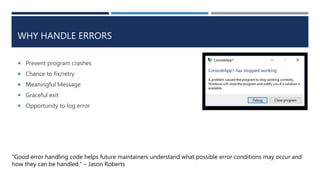

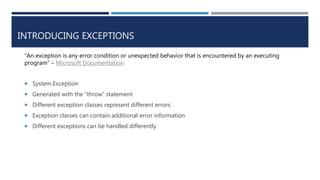
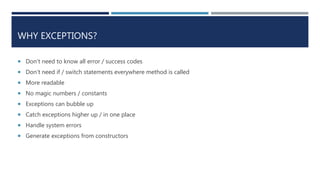

![ILLUSTRATED C# 2012 [BOOK]](https://image.slidesharecdn.com/exceptionguidelinesinc-181024060110/85/Exception-guidelines-in-c-8-320.jpg)
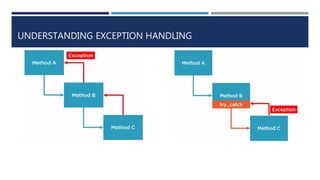
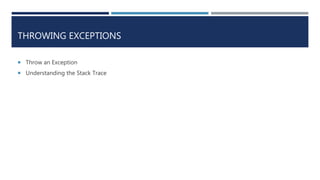
![THROW EXCEPTION GUIDELINE
ïĄ DO specify the inner exception when wrapping exceptions.
ïĄ DO use an empty throw statement (throw;).
ïĄ Do not use exceptions for normal flow of control, if possible [Microsoft]
ïĄ E.g. input validation
ïĄ You expect input to invalid sometimes
ïĄ Not an exceptional situation
ïĄ Part of expected logic flow
ïĄ IsValid(xxx) method(s)
ïĄ DO NOT throw a System.Exception or System.ApplicationException.
ïĄ DO NOT have public members that return exceptions as the return value or an `out` parameter
ïĄ DO NOT throw exceptions from Exception Filter blocks as it returns false and it will be difficult to debug](https://image.slidesharecdn.com/exceptionguidelinesinc-181024060110/85/Exception-guidelines-in-c-11-320.jpg)


![CATCH EXCEPTION GUIDELINES
ïĄ Catch only exceptions that you can handle
ïĄ Catch only little code that you need
ïĄ Catch exception only once per thread (DO NOT over-catch)
ïĄ Use Exception Logging Libraries
ïĄ CONSIDER terminating the process by calling `System.Environemt.FailFast` instead of throwing an exception if your code
encounters a situation where it is unsafe for further execution [Microsoft]
ïĄ DO NOT Handle Exceptions inside loops
ïĄ DO NOT hide (bury) exceptions you donât fully handle
ïĄ Do not add a catch block that does nothing or just re-throws
ïĄ May just be to log the error
ïĄ Usually bad practice to ignore (swallow / trap) exceptions
ïĄ AVOID catching System.Exception or System.SystemException except in top-level exception handlers that perform final
cleanup operations before rethrowing the exception.](https://image.slidesharecdn.com/exceptionguidelinesinc-181024060110/85/Exception-guidelines-in-c-14-320.jpg)
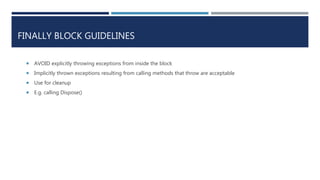
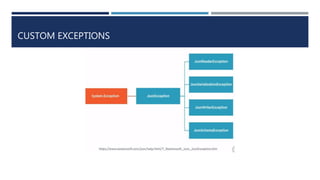


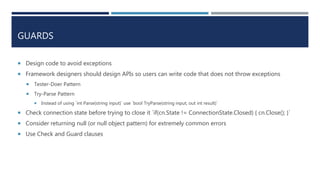
![REFERENCES & DISCUSSION
ïĄ Error Handling in C# with Exceptions by Jason Roberts
ïĄ Microsoft Documentation [Exceptions]
ïĄ Illustrated C# 2012 [Book]](https://image.slidesharecdn.com/exceptionguidelinesinc-181024060110/85/Exception-guidelines-in-c-20-320.jpg)